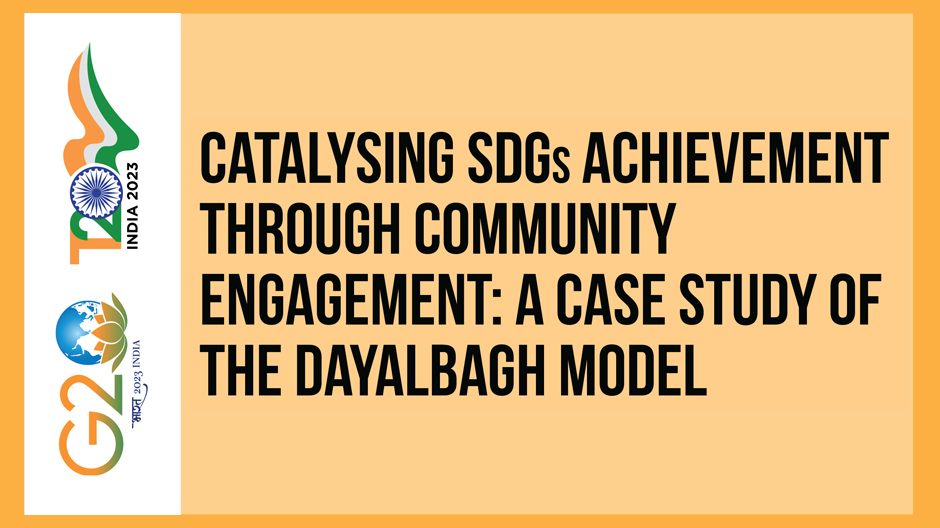Task Force – 1: Macroeconomics, Trade, and Livelihoods: Policy Coherence and International Coordination
The G20 countries face multifaceted challenges in their pursuit of the Sustainable Development Goals (SDGs). Progress has plateaued due to global health crises such as the COVID-19 pandemic, geopolitical tensions, and uneven economic growth. It is imperative, then, to reevaluate the existing strategies aimed at achieving the SDGs. To achieve the SDGs in a timebound manner, this policy brief[a] recommends a shift towards holistic sustainability, integrating the inner dimension of sustainability comprising values, beliefs, attitudes, spiritual and intuitive consciousness, and conscientiousness along with the external dimension that includes environmental, social, and economic factors. The Dayalbagh community in India exemplifies this through the Sigma Six Q-V-A (Quality-Values-Attributes) Model, which embraces responsible production and consumption through six elements: agriculture and dairy, education and healthcare, air quality, water quality, innovation, and human values. The model facilitates the transition towards holistic sustainability that encompasses the principles of Lifestyle for Environment (LiFE). The G20’s role is vital in fostering holistic sustainability through a community-centric approach that promotes responsible production and consumption, fosters innovation, advocates sustainable agriculture, prioritises education and healthcare, and enhances community engagement.
1. The Challenge
The pursuit of the Sustainable Development Goals (SDGs) encounters multifaceted challenges stemming from intricate interdependencies among social, economic, and environmental dimensions. Using the SDG Index by Sachs et al. (2018), this brief assesses the G20 countries’ advancement in Figure 1, categorised into the G7, BRICS (Brazil, Russia, India, China, and South Africa), Asia Pacific, Latin America, and West Asia.[b] This brief finds that despite initial impetus, progress towards realising the SDGs has plateaued across G20 nations. Obstacles like global health crises, political discord, and uneven economic growth have disrupted envisioned trajectories. Addressing these challenges demands concerted international cooperation, innovative policy frameworks, and sustained commitment from governments, organisations, and individuals alike.
Figure 1: Trends in SDG Index for G20 countries (2000-2023)
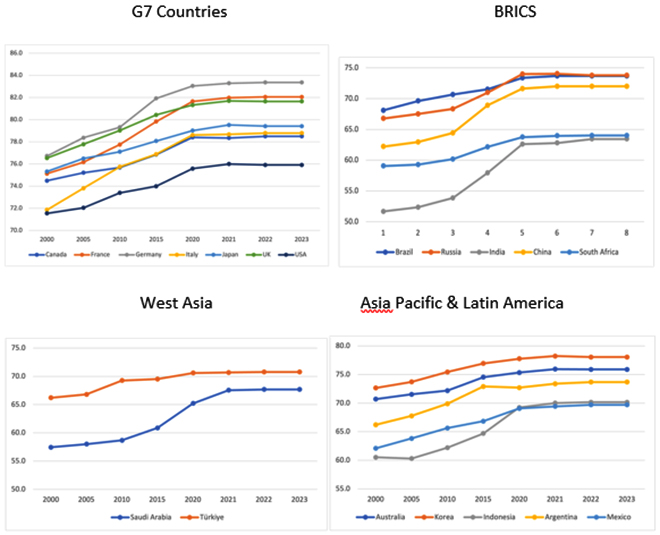
Source: Authors’ compilation based on data from sdgindex.org
Realising the SDGs within defined timeframes demands a fundamental change that transcends the conventional focus on the three external dimensions—economic, social, and environmental (Plag and Jules-Plag, 2019). Following Dua et al. (2023), one way to characterise holistic sustainability is to include aspects from the external (environmental, social, and economic) as well as the internal (people’s values, beliefs, attitudes, intuitive and spiritual consciousness, and conscientiousness) dimensions. Figure 2 shows that achieving holistic sustainability requires the integration of the inner and external dimensions. By emphasising the inner dimension, the influence of external dimensions can be enhanced, resulting in more enduring strategies and solutions. The former acts as the basis of sustainable development, playing a pivotal role in protecting both humanity and the planet while fostering prosperity.
Figure 2: Holistic sustainability
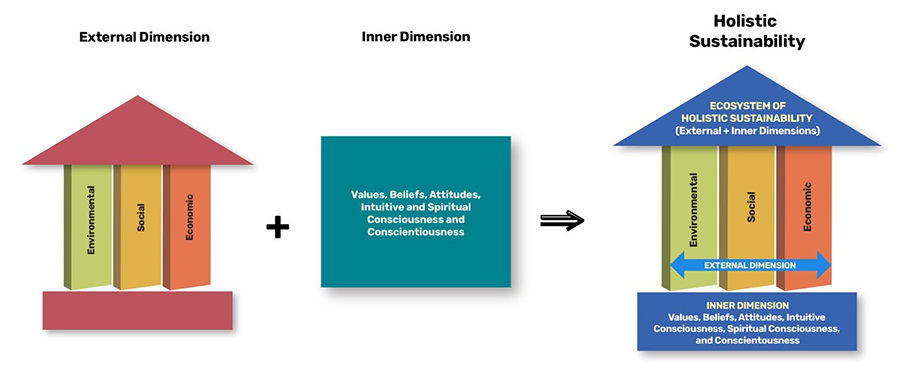
In this framework, communities play a central role by embodying and nurturing the values that drive collective action and promote well-being, equitable progress, and environmental consciousness. The significance of local communities in advancing sustainability has also been acknowledged in Agenda 21 from the 1992 Rio Summit, through initiatives like Local Agenda 21 (Bayulken and Huisingh, 2015; Khan et al., 2018; Moallemi et al., 2020). Ultimately, the bottom-up approach recognises that sustainable progress is most robust when communities are at the forefront of change. Figure 3 shows how individual change can trigger a ripple effect that advances planetary well-being as it spreads through communities, districts, states, and nations and the globe. Thus, a bottom-up approach, with individuals as catalysts for change supported by communities is indispensable for SDG achievement.
Figure 3: Individual to planetary well-being
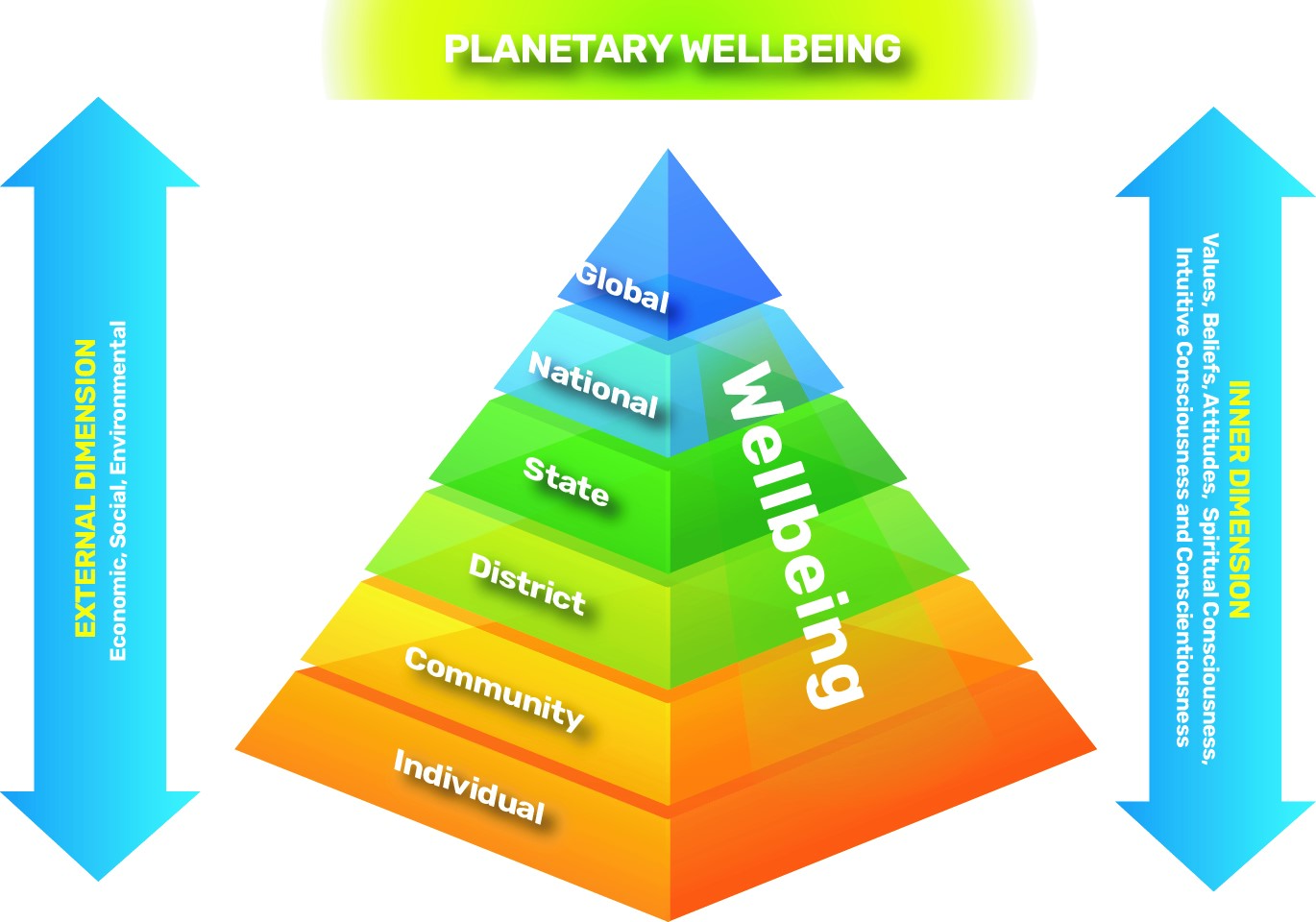
Source: Authors’ creation
An illustration of a community-based holistic sustainability can be seen at Dayalbagh,[c] Agra in Uttar Pradesh, India. Dayalbagh, which translates as the “Garden of the Merciful” in English is a cutting-edge eco-village and healthcare habitat. It serves as the Radhasoami Satsang Community’s headquarters and is a self-contained colony of the adherents of the Radhasoami faith. The residents’ way of life is informed by the Sigma Six Qualities-Values-Attributes (Q-V-A) model[d] (see Figure 4), which embraces responsible consumption and production through the six elements of agriculture and dairy, education and healthcare, water quality, air quality, innovation, and human values.
Figure 4: Sigma Six Q-V-A Model of Dayalbagh Community
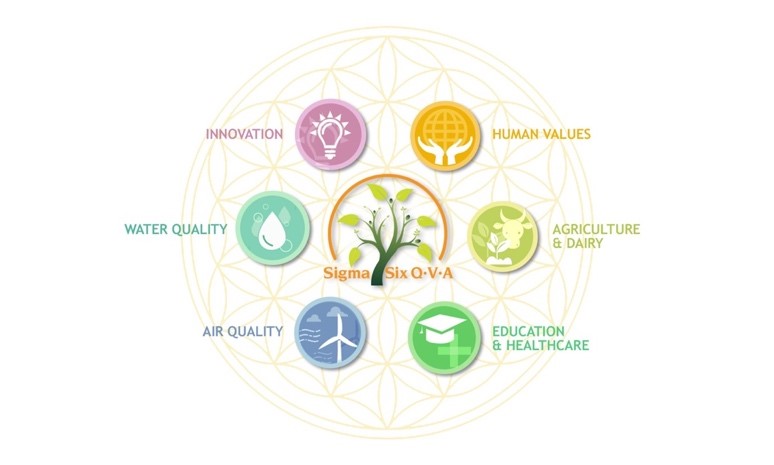
Source: Radhasoami Satsang Sabha, 2019
Agriculture and dairy: Agriculture, including dairy farming, plays a pivotal role in supporting SDG 1 (no poverty), SDG 2 (zero hunger), and SDG 8 (decent work and economic growth). Agroecological and precision farming practices are given prime importance in Dayalbagh where members of the community irrespective of income level, status or occupation, perform voluntary selfless service in the agricultural fields. These practices at Dayalbagh prioritise resilient farming systems, conservation of resources, and enhancement of biodiversity (Yeats-Brown 1936, DEI, 2022). Table 1 gives details of agricultural practices at Dayalbagh and their impact on SDGs.
Table 1: Agricultural practices at Dayalbagh and external and inner dimensions of sustainability
| Features: Agriculture and Dairy | SDGs Impacted | SDGs Reinforced Through |
| External Dimension (Environmental, Economic, Social) | Inner Dimension (Values, Beliefs, Attitudes, Spiritual and Intuitive Consciousness and Conscientiousness) | |
| Agroecology and precision farming practices
• Co-existence of multiple bio-ecosystems such as crop fields, vegetable gardens, fruit orchards, fodder fields, medicinal herb gardens, and biodiversity parks • Crop diversification • Intercropping • Crop rotations, often including legumes • Integration of animals into farming • Organic farming • Sensors for soil temperature, humidity, wind speed and direction, climatic conditions, and rain • Multi-land use model with solar agricultural farms (farming is done on land below solar modules) • Proper crop classification, timely planting and irrigation of crops and appropriate irrigation methods • Use of technologies such as smart truck tracking to increase efficiency
Dairy and Cattle Shed • Crop-livestock integration • Technological interventions to improve breeding, nutrition, and health management • State-of-the-art dairy facility (Food Safety and Standards Authority of India and Hazard Analysis Critical Control Point Certified) Ecological Consciousness • Organic farming • Use of recycled water for irrigation • Zero waste • Tree plantations |
• SDG 1 (no poverty)
• SDG 2 (zero hunger) • SDG 3 (good health and well-being) • SDG 4 (quality education) • SDG 5 (gender equality) • SDG 10 (reducing inequality) • SDG 13 (climate action) • SDG 16 (peace, justice, and strong institutions) |
• Zero waste and optimal utilisation of resources • Hard work • Shared responsibility • Respect for one another • Respect for environment • Fostering equality • Humane treatment of cattle
Community Engagement • Community cooperation and cohesion (2Cs) • Voluntary service for at least four hours a day
|
Source: Adapted from Dua et al. (2023)
Education & Healthcare: Education intersects with all SDGs. It has been given prime importance in Dayalbagh (Radhasoami Satsang Sabha 2019). Dayalbagh Educational Institute’s (DEI) educational policy emphasises the holistic development of a student through unique curricula, community engagement, and entrepreneurial programmes (DEI 2018). The focus is on serving society through outreach programmes such as medical camps. The education system nurtures intuitive consciousness for a fulfilling life path. Applying the systemic approach of the Sigma Six Q-V-A model to education at the DEI has led to remarkable accolades, including the grant of numerous patents. Table 2 gives details of these features of education at Dayalbagh and how they relate to SDGs,
Table 2: Features of education at Dayalbagh and its relation to SDGs
| Features: Education At Dayalbagh | SDGs Impacted | SDGs Reinforced Through |
| External Dimension | Inner Dimension | |
| i. Education System
• Affordable and accessible education for all • Broad-based core courses including agriculture, environmental studies, and social services • Education from “Maternity to Eternity”[e] (3 Weeks to Ph.D. to DSc to Spiritual Education) • Reaching the last, the least, the lowest, and the lost[f] • Social service-based village adoption programmes • Skilling rural women and youth • Skill development and vocational and technical training • Entrepreneurial education including earn while you learn and life-long learning
ii. Innovation & outreach • Research and frugal innovation • Distance education programmes and application of information, communication and technology in teaching, research, and outreach • Collaboration with national and international institutes • Focus on rural, tribal, and under-privileged communities iii. Conservation of biodiversity iv. Environmental consciousness • Mandatory core courses on Environmental Studies • Focus on zero waste • Emphasis on community service for maintaining cleanliness in and around campus |
• SDG 1 (no poverty)
• SDG 4 (quality education) • SDG 5 (gender equality) • SDG 6 (ensure access to water and sanitation) • SDG 7 (affordable and clean energy) • SDG 8 (decent work and economic growth) • SDG 10 (reduce inequality) • SDG 11 (sustainable cities and communities) • SDG 12 (responsible consumption and production) • SDG 13 (climate action) • SDG 16 (peace, justice, and strong institutions) • SDG 17 (partnerships for the goals) |
i. Values Inculcated
• Hard work • Integrity • Self-reliance • Selfless service • Cooperation • Honesty • Sincerity • Dignity of labour • Humility ii. Evolution of a “complete person” with the following qualities: • Intellectual strength • Scientific temper • Emotional maturity • Truthfulness • High moral character • Simple living • Dedication to duty and discharge of obligations • Awareness of one’s duties and obligations to society • Inter-disciplinary outlook, good general knowledge, sound aptitude, and understanding of society.
iii. Service to mankind • Honorary service by faculty and staff including those in senior administrative positions such as the director (vice-chancellor), registrar, and treasurer
Community Engagement • Support from sponsoring body • Strong alumnae association • Advisory committee on education: a non-statutory body comprising of eminent and experienced academicians and educationists that serve as a think tank |
Source: Adapted from Dua et al, 2023
In a similar vein, there is no denying the significance of healthcare for sustainable development. Dayalbagh focuses on providing the last, the least, the lowest and lost with access to high-quality healthcare and education from “maternity to eternity.” The relationship between the SDGs and the distinctive characteristics of these aspects at Dayalbagh is shown in Table 3.
Bottom of FormTable 3: Features of healthcare at Dayalbagh and its relation to SDGs
| Features: Healthcare At Dayalbagh | SDGs Impacted | SDGs Reinforced Through |
| External Dimension | Inner Dimension | |
| i. Treatment of disease
• Charitable health and medical facilities (allopathic, homoeopathic, and AYUSH i.e., Ayurveda, Yoga, Naturopathy, Unani, Siddha, and Homeopathy) • Free medical camps ii. Prevention of disease • Availability of affordable nutritious food for all through community kitchen • Traditional nutritional supplements like chyawanprash[g] and millets • Subsidised organic milk • Nutritional supplements for children • Organic fruits and vegetables at nominal prices iii. Physical fitness • Regular exercise through physical training • Fieldwork Conservation of environment • Regular monitoring of air and water quality • Use of solar power for community as well as residential buildings |
• SDG 1 (no poverty)
• SDG 2 (zero hunger) • SDG 3 (good health and well-being) • SDG 10 (reduce inequality) • SDG 13 (climate action) |
• Humility • Duty • Compassion • Universal brotherhood and sense of shared social responsibility • Connection with nature
Community Engagement • 2Cs • Selfless service
|
Source: Adapted from Dua et al., 2023
Water Quality: Water is intricately tied to several SDGs. Dayalbagh has focussed on ensuring access to clean and safe drinking water through proper treatment and monitoring. The state of ground water is also reflected in the earth leakage resistance, which is maintained by Dayalbagh at very low levels (DEI 2023). It is also at the forefront of addressing water scarcity, pollution, and sanitation facilities (DEI 2022b). Moreover, Dayalbagh’s initiatives in cleaning up the banks and surroundings of river Yamuna help to create awareness amongst the members of the neighbouring communities towards sustainable conservation and development of the adjoining areas. Table 4 gives details of the efforts at Dayalbagh to maintain and improve the water quality and its relationship to SDGs.
Table 4: Features of Water Quality and its Relation to SDGs
| Features: Water Quality At Dayalbagh | SDGs Impacted | SDGs Reinforced Through |
| External Dimension | Inner Dimension | |
| i. Access
• Clean and safe drinking water for all • Monitoring of water quality
ii. Treatment • Sewage treatment plant (STP) • Treatment of water with potassium permanganate or alum
iii. Conservation • Reviving old dry wells • Treated water from STP used for agriculture • Conservation at household and community levels • Clean-up of river Yamuna |
• SDG 3 (good health and well-being)
• SDG-5 (gender equality) • SDG 6 (clean water and sanitation) • SDG 10 (reduce inequality) • SDG 11 (sustainable cities and communities) • SDG 12 (responsible consumption and production) • SDG 13 (climate action) • SDG 14 (life below water) • SDG 15 (life on land) • SDG 17 (partnership for the goals) |
• Connection with nature
i. Community engagement • Preserving the water quality • Conservation of all resources including water • 2Cs • Duty • Responsibility |
Source: Adapted from Dua et al., 2023
Air Quality: Addressing air pollution aligns with SDGs 3, 8, and 11, fostering economic growth and resilient communities while safeguarding ecosystems (SDG 15) for long-term sustainable development. With various initiatives to reduce pollution levels, including planting trees, developing biodiversity parks, and encouraging organic agroecology-cum-precision farming practices, Dayalbagh contributes to better air quality (Lakhani, 2021; Satsangi, 2021) through multifaceted approaches which lead to reducing the carbon footprint of the community (DEI 2022b). Table 5 below enumerates the features and the external and inner dimensions of sustainability.
Table 5: Features of air quality and its relation to SDGs
| Features of Air Quality at Dayalbagh | SDGs Impacted | SDGs Reinforced Through |
| External Dimension | Inner Dimension | |
| i. Reducing carbon footprint
• Electric vehicles for intra-colony travel • Solar thermal cooking in community kitchen • Piped gas for cooking • Cordoning off dust generating activities • Solar power for community facilities, university, and residential dwellings • Economical use of energy and resources
ii. Monitoring air quality • Regular measurement and reporting of air quality index
Reducing pollution • Misting and spraying with fine water droplets • Planting trees and pollution-absorbing plants • Wind augmentation air purifying unit at various sites to reduce pollution by trapping pm 2.5 and pm 10. • Use of renewable energy for battery banks |
• SDG 7 (affordable and clean energy) • SDG 11 (sustainable cities) • SDG 12 (responsible consumption and production) • SDG 13 (climate action) |
• Environmental consciousness
• Connection with nature
Community Engagement • 2Cs • Shared core values and beliefs • Duty • Responsibility
|
Source: Adapted from Dua et al., 2023
Human Values: Human values are integral to fostering all SDGs. Embedding values can help societies harmonise economic, social, and environmental aspects, contributing to broader SDG achievements and long-term well-being (Satsangi et al., 2023). Table 6 gives details of the values fostered at Dayalbagh. The community promotes a simple and modest lifestyle, valuing contentment and moderation over material possessions (Brunton, 1934; Yeats-Brown, 1936). A strong sense of community with gatherings and communal activities focused on selfless service, equality, and moral and ethical values is fostered.
Table 6: Features of human values and its relation to SDGs
| Human Values at Dayalbagh | SDGs Impacted | SDGs Reinforced Through |
| External Dimension | Inner Dimension | |
| i. Simple living
• Minimalism, no ostentatious expenditure • Adherence to ‘golden mean path’
ii. Zero Waste
iii. Selfless service • Fieldwork, community kitchen, and medical care • Reaching the last, the least, the lowest, and the lost • Upliftment of tribals
iv. Reducing inequalities • No ownership of property • Similar houses • Availability of essential goods and services to all • Women empowerment |
All SDGs | • Encouraging the value of “work is worship”
• Fatherhood of god and brotherhood of man • Better worldliness • Optimal utilisation of resources • Humility
i. Community engagement
• Duty • Equality • Responsibility • 2Cs • Service to mankind |
Source: Adapted from Dua et al, 2023
Innovation: Innovation is intricately tied to multiple SDGs. Within the framework of Dayalbagh, innovation encompasses not only inventive techniques but also system processes and creative strategies used to accomplish goals effectively and efficiently. It defines Dayalbagh’s distinctive way of life of fostering holistic development in alignment with its sustainable vision. In particular, a few unique initiatives of Dayalbagh are listed in Table 7 below:
Table 7: Features of innovation at Dayalbagh and its relation to SDGs
| Features: Innovation at Dayalbagh | SDGs Impacted | SDGs Reinforced Through |
| External Dimension | Inner Dimension | |
|
• Consciousness studies • Renewable energy • Superman evolutionary scheme • Cottage industries
|
All SDGs | • Dignity of labour
i. Community engagement • Service to mankind • 2Cs ii. Environmental consciousness iii. Intuitive consciousness |
Source: Adapted from Dua et al, 2023
The Sigma Six Q-V-A model of Dayalbagh plays a crucial role in supporting neighbouring communities through its outreach efforts, such as medical camps, with particular focus on improving the trinity of air quality, water quality, and land quality. This approach promotes a holistic and sustainable enhancement of the environment, benefiting the well-being of residents and the ecosystem.
2. The G20’s Role
The G20 is key in shaping global policies that drive sustainable development. Recognising that comprehensive development goes beyond economic metrics, the G20 can encourage policies prioritising responsible consumption, living in harmony with nature, sustainable resource management, and co-existence and cooperation. It can contribute significantly to empowering local communities and advancing an integrated, bottom-up approach to SDGs that aligns with the spirit of One Earth, One Family, One Future.
Communities are pivotal in nurturing individual transformation towards responsible production and consumption through the inner dimension. Dayalbagh’s scientific model of Sigma Six Q-V-A exemplifies this approach, providing an ecosystem that embraces eco-friendly practices, equity, and holistic well-being across agriculture, education, healthcare, air and water quality, human values, and innovation. This resonates with the Lifestyle for Environment (LiFE) initiative, highlighting the transformative potential of individual choices in promoting sustainability. The relationship between the Dayalbagh model, LiFE, and holistic sustainability is depicted in Figure 5. Embracing the Sigma Six model entails a lifestyle that harmonises with the environment, is anchored in values and ethics, and contributes to holistic sustainability, ultimately advancing the SDGs.
The Sigma Six Q-V-A Model of the Dayalbagh community is a scientifically entrusted model of a socio-economic-technological-spiritual-climatic complex. Furthermore, it has proven to work for more than 100 years and is fundamentally seated in the scientific foundations of topological graph theory and systems theory[h] (Roe, 1966; Satsangi and Ellis, 1971; Satsangi, 2006; Srivastava et al., 2017; Satsangi et al., 2023). The scientific foundation and real-world implementation make it a good case for G20 policymakers to review and take up its recommendations. The case study can serve as a valuable model for the G20 to enhance global collaboration in sustainable lifestyles. Dayalbagh’s successful sustainable community practices can be used by the G20 to inspire multi-stakeholder partnerships to catalyse the mainstreaming of sustainable lifestyles and consumer choices on a global scale. This will effectively drive sustainable development in line with the G20’s principles. The G20 has a unique and transformative role to play in advancing the SDGs by integrating principles from the LiFE initiative, which is encompassed in Dayalbagh’s Sigma Six Model of holistic sustainability. It can pave the way for a future where economic prosperity, social well-being, and environmental preservation are harmoniously interwoven. The adoption of the Sigma Six Q-V-A approach, which promotes the adoption of LiFE as a developmental paradigm, underpinned by ethical values, holds the potential to foster a systemic shift from the well-being of the individual to that of the entire planet.
Figure 5: Relationship between Sigma Six Q-V-A, LiFe, and holistic sustainability

Source: Authors’ creation
3. Recommendations to the G20
In light of the case study presented above, the following recommendations to the G20 are derived from the Sigma Six Q-V-A systems model, which has a scientific foundation grounded in topological graph theory, in addition to the guiding principles of LiFE.
Integrate holistic values in policy and practice:
- Encourage member nations to prioritise and integrate human values into policies and practices, promoting ethical leadership, community engagement, and sustainable livelihoods.
- Raise awareness of the significance of the inner dimensions of sustainability, such as people’s consciousness, conscience-based conscientiousness, values, beliefs, and attitudes. Integrate these inner dimensions with the external dimensions of sustainability to create a holistic approach to sustainable development.
Promote adoption of LiFE:
- Evolve, understand, and absorb LiFE and ethics for the functioning of the economy.
- Encourage countries to champion policies fostering conscientious production and consumption, guiding individuals to make informed decisions that reduce environmental harm. Responsible choices spanning individuals, households, and communities wield substantial influence at broader scales.
Community engagement and empowerment:
- Prioritise community involvement in policy formulation and implementation, fostering ownership and alignment with local needs for sustainable development.
Promote community-centric livelihood strategies:
- Encourage the adoption of community-centric livelihood strategies that empower local communities, especially in the context of agriculture. These strategies should prioritise sustainable farming practices, resource conservation, and equitable distribution of resources within the community.
- Create and support small-scale businesses that can employ women equally among the rural and tribal populations to produce high-quality everyday necessities at cheap cost and minimum profit, all the while encouraging teamwork and a culture of selfless service.
Women empowerment:
- G20 should prioritise women’s empowerment by ensuring their safety through a robust framework involving health, education, physical fitness, and community involvement. By providing quality education and vocational training, women can access skillsets aligned with emerging sectors.
- Moreover, equal opportunities in leadership and entrepreneurship must be promoted.
Promote innovation ecosystems:
- Encourage member-states to establish innovation hubs that support research, technology, and novel approaches, driving sustainable solutions for challenges aligned with the SDGs.
- Allocate resources to research and innovation in sustainable agriculture practices, technologies, and processes. Encourage the development of eco-friendly and efficient farming methods that reduce environmental impact while increasing productivity.
Sustainable agriculture:
- Encourage and support community-based agricultural initiatives (Satsangi 2023) that emphasise sustainable practices, biodiversity conservation, ecological balance, and increased use of technology with the help of local governments. Such approaches can empower local communities to take charge of their agricultural systems, fostering resilience and long-term viability.
- Champion agroecology and precision farming methods to ensure food security, enhance crop yields, and reduce environmental impact, creating resilient agricultural systems.
Quality education and skill development:
- Urge member-states to focus on accessible and quality education, along with vocational training, to equip individuals with skills useful for emerging industries, thereby fostering sustainable livelihoods.
- Promote holistic education and awareness programmes at low cost with intensive use of technology.
Healthcare accessibility:
- Prioritise access to universal healthcare for the improvement of public well-being, productivity, and social resilience, thereby contributing to sustainable development.
Environmental monitoring at community level:
- Implement comprehensive air and water quality monitoring systems at the community level, aiding communitarian participation for informed decision-making and sustainable resource management.
Collaborative partnerships:
- Facilitate international cooperation, knowledge exchange, best practices sharing, and joint projects that align with the SDGs and foster sustainable development globally.
Circular economy practices:
- Advocate circular economy principles to minimise waste, promote resource efficiency, and create sustainable business models that consider long-term societal and environmental well-being.
By incorporating these recommendations, the G20 could leverage the Dayalbagh model’s principles to catalyse sustainable development on a larger scale, contributing to a more equitable, prosperous, and resilient global future.
Attribution: Pami Dua et al., “Catalysing SDGs Achievement through Community Engagement: A Case Study of the Dayalbagh Model,” T20 Policy Brief, October 2023.
Bibliography
Bayulken, Bogachan, and Donald Huisingh. “A literature review of historical trends and emerging theoretical approaches for developing sustainable cities (part 1).” Journal of Cleaner Production 109 (2015): 11-24. Brunton, Paul. “The Garden of the Lord”. In A search in secret India. Pg 163-181. London, New York,: Rider.1934.
Dayalbagh Educational Institute. “DEI Vision Book”. DEI. 2018 https://www.dei.ac.in/dei/files/notices/2019/IOE.pdf
Dayalbagh Educational Institute. “Agroecological Practices of Dayalbagh Educational Institute for the Attainment of a Self-Reliant and Self-Sustained Utopia”. DEI. 2022a. https://www.dei.ac.in/dei/edei/.
Dayalbagh Educational Institute. “Contribution of DEI to UN Sustainable Development Goals”. DEI. 2022 b https://www.dei.ac.in/dei/edei/files/CONTRIBUTION%20OF%20DEI%20TO%20UN%20SUSTAINABLE%20DEVELOPMENT%20GOALS.pdf
Dayalbagh Educational Institute.” Earth Resistance Values in Ohms”. DEI. 2023 https://www.dei.ac.in/dei/edei/files/2023/Earth%20Resistance%20Values%20-%2011.01.2023%20for%20Evening%20Perusal.pdf
Dua, Pami, Arsh Dhir, Apurva Narayan, and Ashita Allamraju. “A Holistic Approach to Achieving SDGs: A Case Study of Dayalbagh, India.” (2023), https://uwspace.uwaterloo.ca/handle/10012/19181.
Khan, Risa, Nicole Thwaites, Hadeikaye Williams, Mekeina McLennon, Diedre O’Connor, Annadjae Roberts, Karina Browne et al. “Community-based Approaches and Measuring the SDGs.” Social and Economic Studies (2018): 67-93.
Lakhani, Anita. “Airborne Particulate Matter and Human Health: The Importance of Mass Concentrations and Oxidative Potential – A Case study”. PARITANTRA Journal of Systems Science and Engineering (2021):5 (1), 24-30.
Moallemi, Enayat A., Shirin Malekpour, Michalis Hadjikakou, Rob Raven, Katrina Szetey, Dianty Ningrum, Ahmad Dhiaulhaq, and Brett A. Bryan. “Achieving the sustainable development goals requires transdisciplinary innovation at the local scale.” One Earth 3, no. 3 (2020): 300-313.
Plag, Hans-Peter, and Shelley-Ann Jules-Plag. “A goal-based approach to the identification of essential transformation variables in support of the implementation of the 2030 agenda for sustainable development.” International Journal of Digital Earth (2019).
Radhasoami Satsang Sabha. “Dayalbagh: Garden of the Merciful (A Pictorial Presentation)” Radhasoami Satsang Sabha, Dayalbagh, Agra. 2019. ISBN: 978-81-89288-95-2
Roe, P. H. Networks and systems. Addison-Wesley Publishing.1966.
Sachs, J., Schmidt-Traub, G., Kroll, C., Lafortune, G., & Fuller, G. (2018). Implementing the goals. SDG index report 2018. Sustainable Development Solutions Network: New York, NY, USA.
Satsangi, Prem S., and Jack B. Ellis. “General systems from network systems: a philosophy of modelling.” International Journal of Systems Science 2, no. 1 (1971): 1-16.
Satsangi, Prem Saran. “Systems movement: Autobiographical retrospectives.” International Journal of General Systems 35, no. 2 (2006): 127-167.
Satsangi, A. “Temporal Distribution and Chemical Characterization of Particulate Matter from a Semi-arid Site: Results from 2010 – 2020.” PARITANTRA Journal of Systems Science and Engineering, 25 (1). (2021): 24-30
Satsangi, Prem. Saran., Anna M Horatschek, & Anand Srivastav. “Consciousness Studies in Sciences and Humanities” (Forthcoming), Springer Nature, Switzerland. 2023
Satsangi, P.S. “Comments for G20 Policy Brief” DEI. October 28,2023. https://www.dei.ac.in/dei/edei/files/2023/GH%20Comments%20for%20G20%20Policy%20Revised%2028.10.2023.pdf
Srivastava, Dayal Pyari, Vishal Sahni, and Prem Saran Satsangi. “From n-qubit multi-particle quantum teleportation modelling to n-qudit contextuality based quantum teleportation and beyond.” International Journal of General Systems 46, no. 4 (2017): 414-435.
Yeats-Brown, Francis, 1886-1944. “An Indian Utopia”. In Lancer at large, by Francis Yeats-Brown. Pg 231- 240. London: V. Gollancz, ltd. 1936
[a] The views expressed in the policy brief are attributed to the authors and do not necessarily represent those of the institutions they represent or of Dayalbagh. Any errors and omissions are the responsibility of the authors.
[b] The European Union as a region has been excluded from the analysis due to data constraints
[c] While there are several communities globally that incorporate sustainable lifestyles and values to achieve the SDGs, this brief focuses on Dayalbagh as an illustrative example. While each community offers unique insights into sustainable practices, Dayalbagh’s case study allows for an in-depth exploration of specific strategies, providing valuable lessons that can inspire and inform broader global efforts towards SDGs.
[d] The model Sigma Six Q-V-A represents a summation of six qualities that define the Dayalbagh community. The summation of these six qualities is greater than the sum of its parts.
[e] Education in Dayalbagh is a lifelong journey commencing with infancy at three weeks old, with children introduced to community service, culture, and heritage through participation in healthcare and self-defence exercises and selfless service in agroecology-cum-precision farming operations in two shifts daily of four hours each. This fosters their relationship with nature for bio-socio-cognitive development from a very young age and makes them Global Conscious Citizens. This journey then transcends to conventional education, including school, university and advanced degrees like PhD and DSc. This provides a long-lasting foundation for continuous, lifelong learning and overall physical, mental and spiritual development with a commitment to the community, nation, and world at large.
[f] Reaching the last, the least, the lowest, and the lost refers to the upliftment and empowerment of marginalised and vulnerable sections of society, including (but not limited to) women and children through need-based, low-cost or even free-of-cost quality education/vocational education at their doorstep, especially in remote and tribal areas through the outreach programme.
[g] Chyawanprash is a traditional ayurvedic health supplement, enriched with herbs and minerals, the consumption of which helps to restore strength and vitality and improve general health.
[h] The field of study known as Abstract Mathematics of Topological Graph Theory has its roots in the 18th century. This scientific discipline, led globally by its pioneers, Rev. Prof. Prem Saran Satsangi, along with Prof. Jack Ellis and Prof. Peter Roe, has been put into practical application at Dayalbagh. For more information on the implementation of the Systems Framework, refer to “Autobiographical Retrospectives” (Satsangi 2006).



